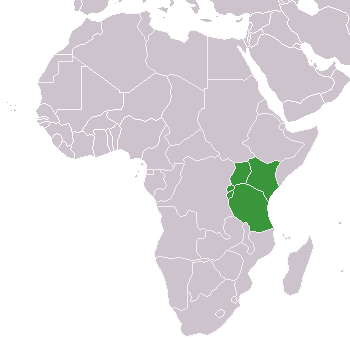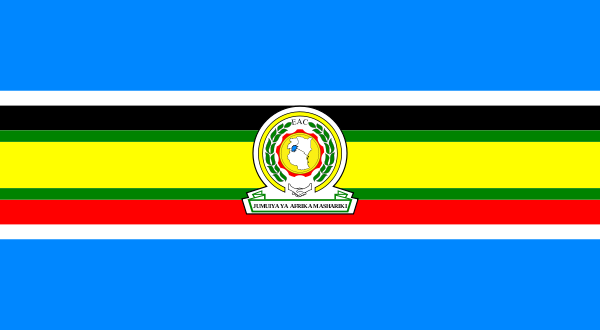East African Community
 |  |
Name: East African Community | |
| Acronym: EAC | |
| Year of foundation: 1999 | |
| Headquarters: Arusha, Tanzania | |
| EAC documents: go to page | |
| Official web site: go to page | |
FOCUS ON | |
| East African Legislative Assembly |
Description
The East African Community is an international organization whose final aim is to develop a complete integration of its members into an East African Federation.
Member countries
EAC has five member states:





Brief History
The drive for the transformation of the East African region, particularly Kenya, Tanzania and Uganda, into a functioning entity with rights and duties in International Relations is not new. It dates back to the time when the three East African colonies were still objects of International Law.
However, the aspirations for regional cooperation in East Africa acquired individual sovereignty and legitimacy in the post colonial state in the 1960s driven largely by the Pan-Africanist East African leaders, Jomo Kenyatta (Kenya), Julius K. Nyerere (Tanzania) and Milton A. Obote (Uganda). More specifically, the three East African leaders were, initially at least, interested in ushering in political federation as a springboard for regional integration. This desire was reinforced with their 1963 Nairobi Declaration in which the leaders committed themselves to establishing an East African political federation in 1964 reiterating, among other things, that, “we believe a political federation of East Africa is desirable by our people. There is throughout East Africa a great urge for unity and an appreciation of the significance of federation”.
However, the independence national interest realities undermined the drive for political federation.
Prelude to the establishment of the EAC
Realising that political federation objective was not achievable, the East African political and ruling elites under the leadership of, Kenyatta, Nyerere and Obote reconceptualised their strategy by opting for economic-driven neo-functionalist-cum-functionalist regional integration process. In 1967, the leaders signed the East African Co-operation treaty, which established the East African Community I (EAC I). The envisaged impact of economic co-operation on the EAC integration process with inherent spillover effect did not withstand the intra-and inter-national complexities and differences, culminating into the disintegration of the regional organization in 1977.
However, the disintegration of the EAC I, did not bury the aspirations of the East African ruling elites from re-establishing a viable regional organization for harnessing areas of co-operation. These aspirations were tangibly incorporated in the East African Community Mediation Agreement (hereinafter, the Mediation Agreement) concluded in 1984 by the three countries for purposes of the division of the EAC I assets and liabilities. Article 14 (2) of the Mediation Agreement, for example, provides that “the States agree to explore and identify further areas for future co-operation and to work out concrete arrangements for such co-operation” (Kenya 1988). These developments were further reinforced by the October 1991 meeting between Presidents Daniel arap Moi (Kenya), Ali H. Mwinyi (Tanzania) and Yoweri K. Museveni (Uganda) in Harare, Zimbabwe, during the Commonwealth Heads of State or Government Summit. The meeting and the evolving rapprochement among the East African leaders set the stage and momentum for tangible actualisation of the spirit of the Mediation Agreement.
The East African Presidents met in Nairobi, Kenya, in November 1991 and set up a committee of Foreign Affairs Ministers with the mandate to explore the modalities for promoting further cooperation in the region. The negotiations by the Ministers culminated into the establishment of a Permanent Tripartite Commission (hereinafter, the Commission) for East African Cooperation in November 1993 and a Permanent Secretariat for the Commission in November 1996. The Secretariat for the Commission set in motion regional reconstruction and more specifically, the operational structures and functions of the East African Cooperation. The core mandate of the Commission was to lay the foundation for econo-political and socio-cultural development for the benefit of the people of the region. In order to achieve these objectives, the Commission developed specific strategic plans for action and implementation.
The Commission prepared the first East African Cooperation Development Strategy (EAC-DS) covering the period 1997-2000. The core objective was to, inter alia; upgrade the Mediation Agreement into a treaty, a mandate which was successfully accomplished. The treaty establishing the EAC II (hereinafter, EAC) was signed by Presidents Moi (Kenya), Museveni (Uganda), and Benjamin Mkapa (Tanzania) on 30th November 1999, which thereafter came into force on 7thy July 2000. The ratification of the treaty by Burundi and Rwanda has, in many respects, broadened the socio-economic and political scope of the EAC.
Institutions and decision-making procedures
The Summit
The Summit is composed of the Heads of State or Government, whose main mandate is to ensure that the organization is pursuing its objectives in conformity with the obligations of the treaty. Its other operational functions include, among other things, reviewing progress on political federation; considering and approving annual reports; and assenting to Bills of the EALA. The Bills assented to by the Summit become the Acts of the Community. The treaty also confers legislative powers on the Summit, a statutory responsibility which has the potential of undermining the role of the EALA. Article 11 (6) of the treaty provides that “An Act of the Community may provide for the delegation of any powers, including legislative powers, conferred on the Summit by this treaty or by any Act of the Community, to the Council or to the Secretary General”. Unless an extraordinary meeting is requested by a member state, the Summit holds its meetings once a year, with the Office of the Chairperson held on rotational basis.
The decisions of the Summit during its meetings are arrived at through a consensus, a process which not only allows debate among the members but that it discourages the winner-take-all system inherent in the majority rule. More, specifically, by incorporating consensus as the most viable option for decisions within the Summit meetings, the founding fathers took cognizance of the difficulties the EAC may face if a stalemate arises over an issue. Disagreements within the Authority of Heads of State or Government of the EAC I, the equivalent of the EAC II Summit, particularly between Presidents Nyerere and Idi Amin Dada of Uganda in the early 1970s, was one of the key factors that rendered the operations of the Community dysfunctional and its eventual disintegration. Suffice it to say, the drafters of the treaty took cognizance of the potential déjà vu, if a stalemate were to encroach the Summit deliberations.
The Council
The Council of the EAC comprises of the Ministers who are in charge of regional cooperation in each of the partner states. The Council is the main policy organ of the EAC with statutory responsibility to, inter alia, oversee and promote the implementation of the EAC’s vision and mission; give directions to the EAC organs, except the Summit, the EALA and the EACJ; scrutinise the budget and submit reports to the Summit; establish Sectoral Councils and Sectoral Committees for purposes of proper operations of the EAC; and initiate Bills to the EALA. As in the case of the Summit, the legislative responsibility conferred on the Council has the potential of usurping the role of the EALA, particularly in a situation where the two organs disagree on policy issues.
The Council meets twice a year, with one of its meetings held in advance before the Summit meeting. The Council is the organ that directly reports and advises the Summit on the implementation and development of the EAC objectives. This is not to argue that the Summit does not have the authority to request a meeting with any other organ of the Community. The Council also has the option of convening an extraordinary meeting, usually at the request of a member state or the Chairperson of the Council. Extraordinary meetings are convened to deal with pending or pressing EAC-related issues. Consensus is the main principle that guides its decision-making process during its meetings.
The Secretariat and the Secretary-General
The Secretariat is the executive organ of the EAC, responsible for the operations of the Community in conformity with the treaty. The Secretary General is the EAC’s principal executive officer appointed by the Summit on a fixed five year rotational basis. The Secretary General is not only in-charge of the Secretariat but also serves as the EAC accounting officer and secretary of the Summit. The other key officers of the EAC are the Deputy Secretaries General and the Counsel, with the latter serving as the legal adviser to the Community. The Secretary General and the EAC staff are immune from civil process and immigration restrictions while performing their official duties prescribed in the treaty. As international civil servants, they are charged with the responsibilities to exercise their duties without due influence from a partner state and to uphold the Community’s international legal personality within the spirit of the treaty.
The East African Court of Justice
The EACJ is the judicial organ of the Community responsible for ensuring adherence to the law, that is, interpretation and application of the treaty. The EACJ comprises of ten judges appointed for a maximum of seven years by the Summit. The President and Vice-President of the Court are appointed by the Summit on a one-term rotational basis. A judge is expected to serve the full term of office as prescribed in the treaty unless he or she resigns; is seventy (70) years of age; dies; or removed by the Summit after the submission of a recommendation of an independent tribunal, a body comprising of legal experts who are also appointed by the Summit.
The EACJ has the initial jurisdiction over the interpretation and application of the EAC treaty. The Court also has the original, appellate and human rights jurisdictions on issues associated with the treaty. For example, partner states; the Secretary General as well as legal and natural persons have the right to seek redress on the grounds of the infringement of the EAC treaty by a member state. The EACJ also has jurisdiction to hear cases involving the EAC and its employees. The EACJ may be called upon by a partner state to arbitrate an agreement to which the EAC or a partner state is a party. Rulings of the Court are based on majority verdict. The Court has attempted, albeit with difficulties and challenges, to exert and consolidate its independence by delivering rulings brought before it for adjudication, some of which are considered controversial.
As shown by different jurisdictional cases, it can be argued that the supremacy of the EAC legal regime is slowly taking root in the region. Even though the partner states reacted with hostility against its ruling, the decision by the EACJ has set precedence within the EAC that will go a long way in laying the foundation for the recognition of the EAC institutions for governance.
The Coordination Committee
The Committee consists of Permanent Secretaries of Ministries of regional cooperation of the partner states. Its meetings are held twice a year prior to the Council’s meetings to enable the Committee to coordinate the programme for the Ministers for Regional Cooperation for whom they are directly accountable. The Chairperson, who is appointed on a rotational basis among the members, may convene an extraordinary meeting to deal with specific issues. The Committee’s functions include, for example, preparation of reports for the Council; implementation of the recommendations of the decisions of the Council; and coordination of the reports of the Sectoral Committees.
Sectoral Committees
Sectoral Committees consist of experts on a specific sector. The Committees are established by the Council, through the recommendation of the Coordination Committee, to deal with EAC-related issue areas. The Committees meet as frequently as circumstances may warrant, particularly in order to ensure that proper implementation of the sectoral programmes are adequately fulfilled.
